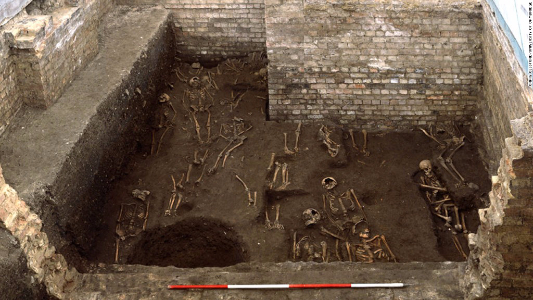Newly released photos show one of Britain’s largest medieval hospital burial grounds, lying beneath a college at the University of Cambridge in southern England.
About 1,300 people are believed to have been buried on the site between the early 13th to 15th centuries, according to research by the university’s Department of Archaeology.
The cemetery lies below what is now the Old Divinity School at St John’s College, built in the 1870s as the Selwyn Divinity School.
St John’s College takes its name from the medieval Hospital of St John the Evangelist, which stood opposite the graveyard until 1511.
Excavation of the site of the hospital’s cemetery took place during refurbishment of the divinity school in 2010-2012 and is detailed in a report published by The Archaeological Journal.
“The documentary evidence indicates that the hospital was established to care for the ‘poor and infirm’ and under the Augustinian rule (adopted in 1250), if not earlier, the hospital was to be for poor scholars or other wretched persons. Pregnant women, lepers, the wounded, cripples and the insane were all specifically excluded,” researchers said.
“The fact that not a single identifiable individual or disarticulated bone could be aged under five years, and that only 6.3% of those in the excavated burials were under ten years old, must either indicate that children this young were not present in the hospital, or that if they were then they were buried elsewhere,” they said.
The cemetery was built over from the mid-17th century, but in 1877 the area was leveled for the building of the school.
Lead researcher Craig Cessford said it appeared indications of a broader cemetery had been ignored during the building of the divinity school, which has substantial wall foundations and cellaring.
“There is no evidence that the existence of the cemetery proper was brought to the attention of the authorities in the 1870s, indicating that the disturbance and re-interment of the human remains was a surreptitious act in contravention of the 1857 Burial Act,” Cessford wrote.
“Many skeletons were presumably removed in their entirety, whilst others were truncated with evidence that some bones that protruded into foundation cuts were pulled out.
“Other protruding bones, perhaps those that proved difficult to pull out, showed signs of being deliberately cut through,” he said.
Researchers estimated that about 40% of the ground was disturbed.
“Although many smaller bones were incorporated into general construction deposits — and also probably removed from the site entirely — the larger and more easily recognizable human bones such as the humerus, tibia, femur, hip bone and crania in particular appear to have been stored on site for a time and periodically disposed of when the trenches for building foundations were backfilled,” Cessford said.
Researchers pointed out that, a decade before, there had been a public outcry when a graveyard was disturbed during the building of London’s St Pancras railway station. Those remains had been reinterred, they said.
“After the burial ground went out of use it is clear that the memory of its presence was long-lived, with disturbance relatively infrequent and a degree of care usually shown to the bones.
“Respect and care were, however, demonstrably absent in the 1870s, when secrecy, illegality and expediency appear to have been overriding factors during construction activity at the site,” the report said.
Nevertheless, 400 complete skeletons in “excellent condition” were found at the site, as well as a network of gravel pathways.
“The extreme stability of the paths is evident since their locations and alignments varying only minutely over time; the cemetery was carefully maintained over the long term. Furthermore, from the perspective of the archaeological project, the paths provided an invaluable aid in phasing the sequence of interments,” researchers said.
They noted a number of unusual burials, including two north-south burials across a pathway in the otherwise predominantly west-east sites.
“The two south-north burials that ‘block’ one of the pathways must represent an officially sanctioned act that was deliberately undertaken to create some form of message.
“As the gravel path was not re-laid afterwards, and there was presumably a low mound above each of the graves, this would have created a lasting visual statement for those using other parts of the cemetery,” they said.
There were few “grave goods” found in the cemetery, likely due to the fact that no clerics were buried there, researchers said.
The only “definitive grave goods” were a jet crucifix and a copper-alloy brooch.
“The crucifix shows signs of wear and polish, indicating long-term use, and was almost certainly a treasured possession,” they said.
It had been slightly damaged, perhaps explaining why it had been discarded in the grave.
Researchers found no evidence of coffins or even definitive evidence for the use of shrouds, again reflecting the poverty of those buried and — until now — hidden by history.



